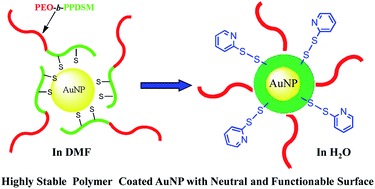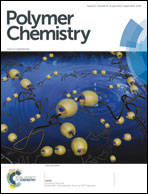Thiol-reactive amphiphilic block copolymer for coating gold nanoparticles with neutral and functionable surfaces†
Abstract
Nanoparticles designed for biomedical applications are often coated with polymers containing reactive functional groups, such as –COOH and –NH2, to conjugate targeting ligands or drugs. However, introducing highly charged surfaces promotes binding of the nanoparticles to biomolecules in biological systems through ionic interactions, causing the nanoparticles to aggregate in biological environments and consequently undergo strong non-specific binding to off-target cells and tissues. Developing a unique polymer with neutral surfaces that can be further functionalized directly would be critical to develop suitable nanomaterials for nanomedicine. Here, we report a thiol-reactive amphiphilic block copolymer poly(ethylene oxide)-block-poly(pyridyldisulfide ethylmethacrylate) (PEO-b-PPDSM) for coating gold nanoparticles (AuNPs). The resultant polymer-coated AuNPs have almost neutral surfaces with slightly negative zeta potentials from −10 to 0 mV over a wide pH range from 2 to 12. Although the zeta potential is close to zero we show that the PEO-b-PPDSM copolymer-coated AuNPs have both good stability in various physiological conditions and reduced non-specific adsorption of proteins/biomolecules. Because of the multiple pyridyldisulfide groups on the PPDSM block, these individually dispersed nanocomplexes with an overall hydrodynamic size around 43.8 nm can be directly functionalized via disulfide-thiol exchange chemistry.


 Please wait while we load your content...
Please wait while we load your content...